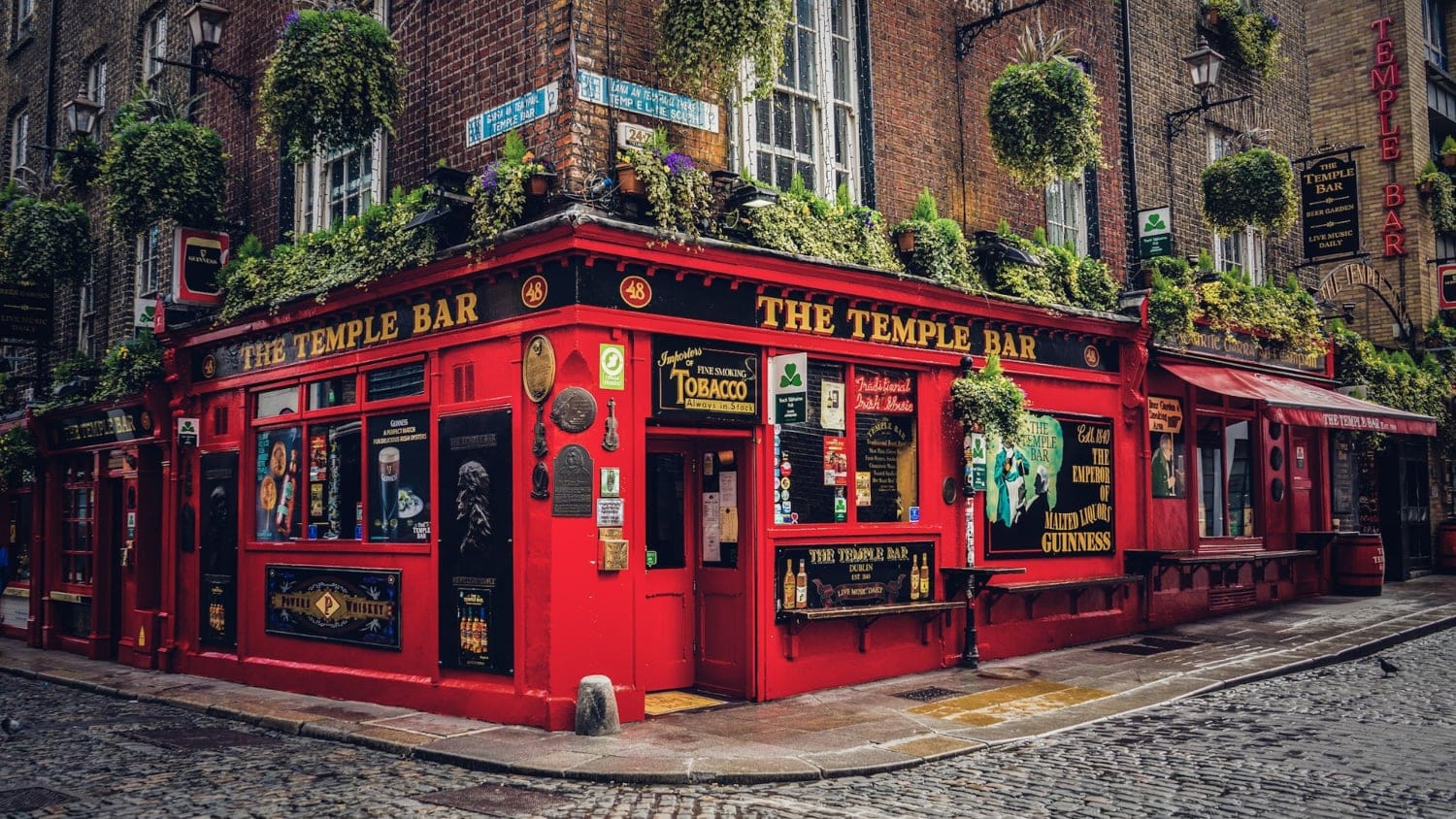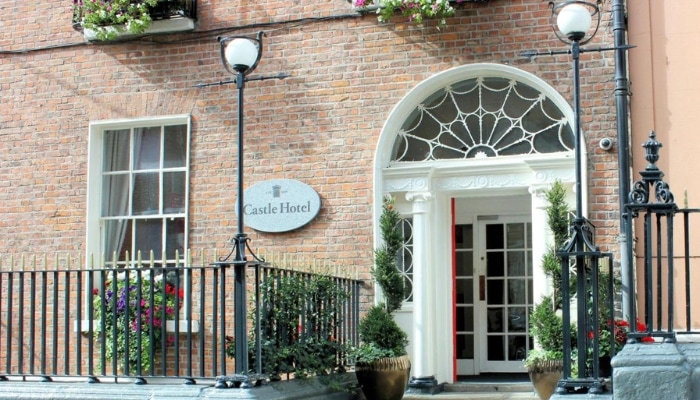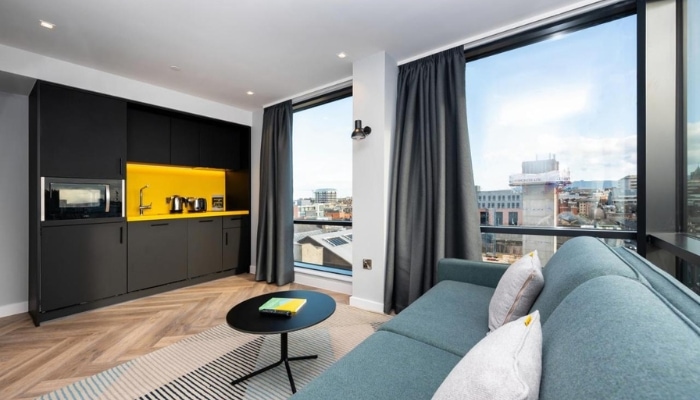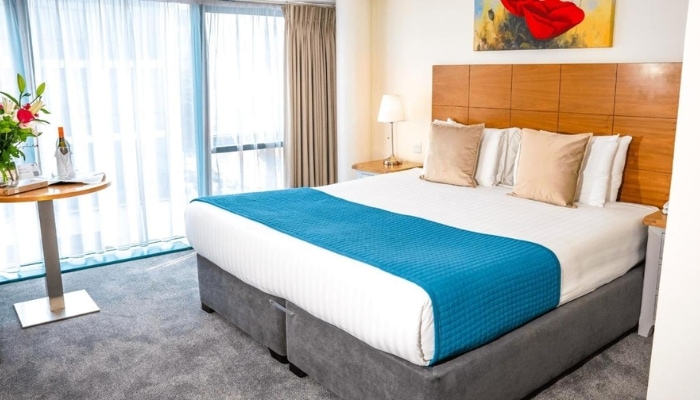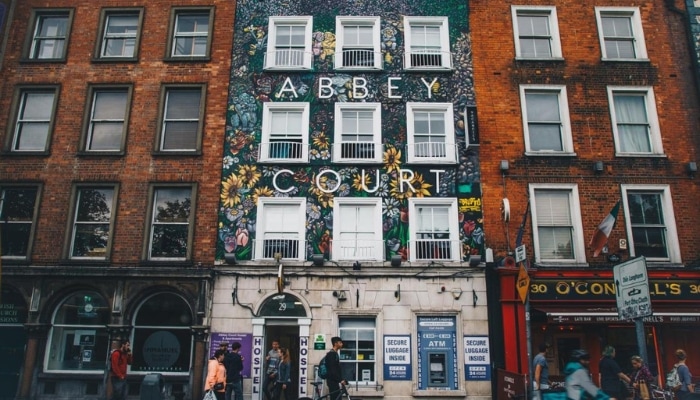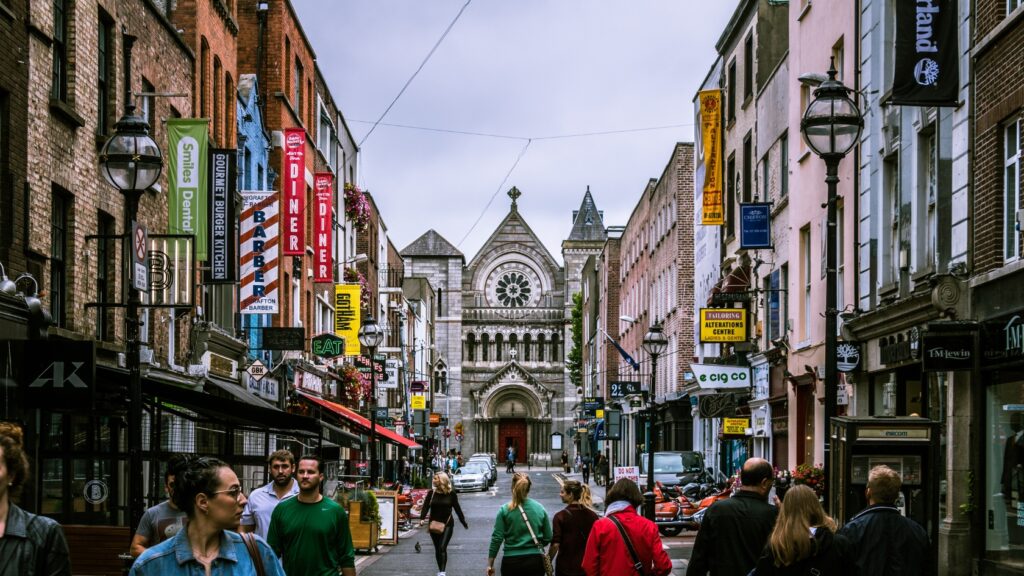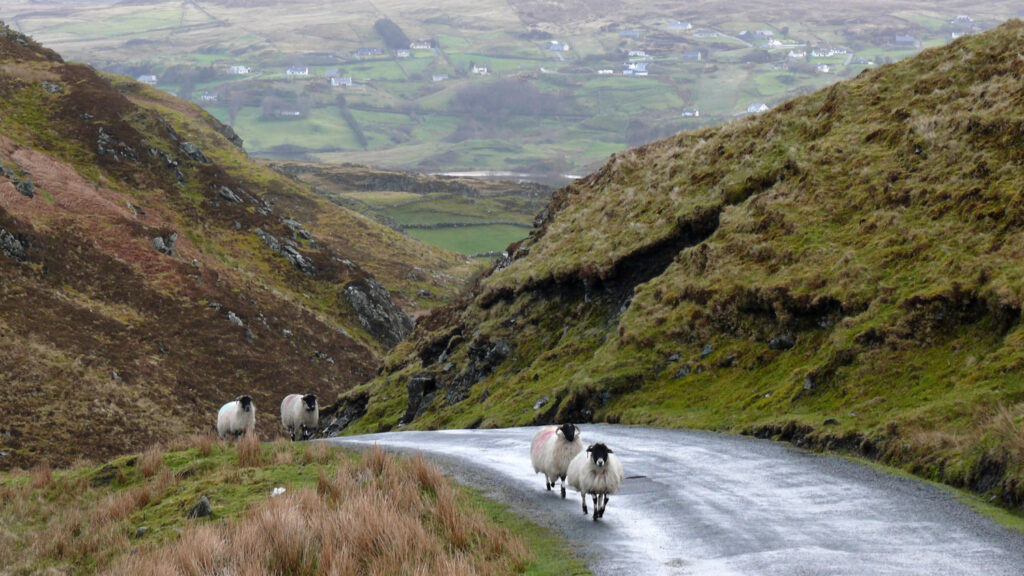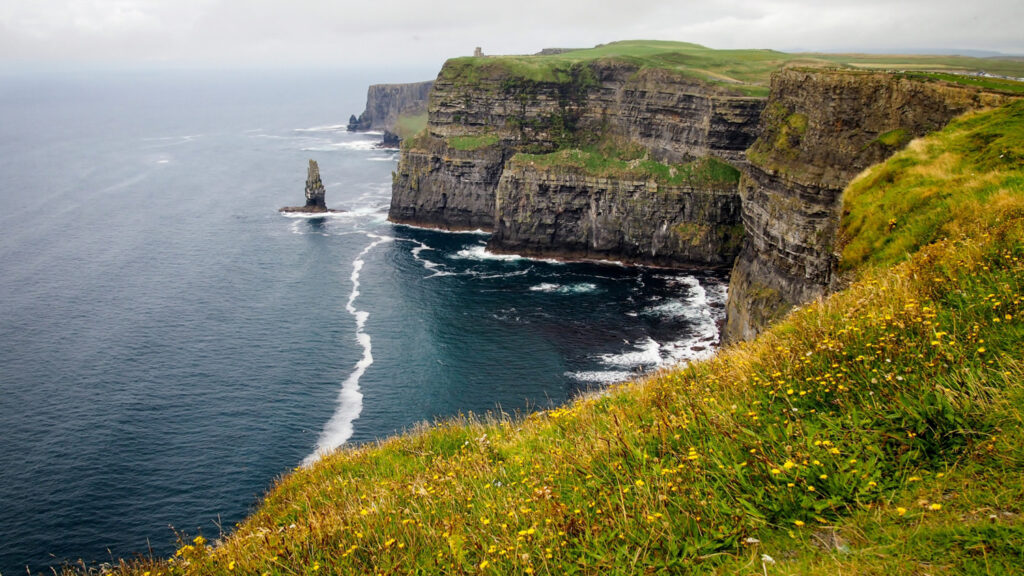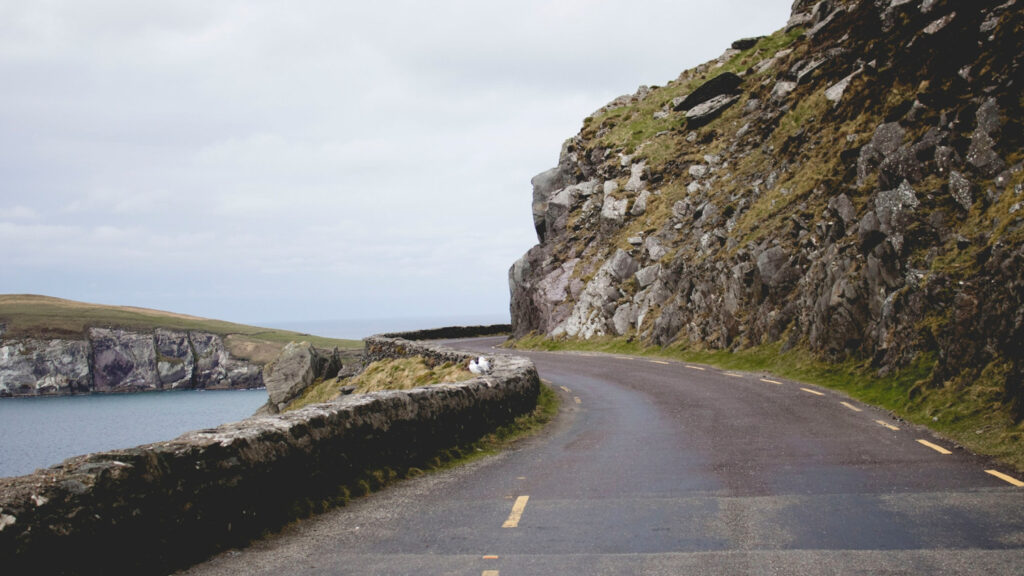Dublin will delight you with its long history, interesting museums, traditional pubs and incredibly friendly people. See the things to do in Dublin, practical tips and a map.
Today we’ll take a look at the best places and sights to visit in Dublin to build your itinerary for 1, 2 or 3 days in Dublin. We’ll also add tipshow to enjoy your visit to Dublin (transport, public transport, food, prices, accommodation, map).
- Dublin
- Things to do in Dublin: Best places to visit
- 1. Trinity College
- 2. Molly Malone statue
- 3. Grafton Street – things to do in Dublin
- 4. St Stephen's Green
- 5. National Museum of Ireland
- 6. Merrion Square
- 7. Temple Bar
- 8. Guinness Storehouse – things to do in Dublin
- 9. St Patrick's Cathedral
- 10. Christ Church Cathedral
- 11. Dublin Castle
- 12. Teeling Whiskey Distillery
- 13. Ha'penny Bridge
- 14. The Spire and O'Connell Street
- 15. Jameson Distillery Bow St.
- 16. EPIC – The Irish Emigration Museum
- 17. Phoenix Park
- 18. National Botanic Gardens
- 19. Dublin alleys
- 20. Cliffs of Moher
- Top 10 places to visit in Dublin
- Where to stay in Dublin
- Best Things to do in Dublin – Map
- Dublin prices
- Where to eat in Dublin
- Dublin Pass: How to save in Dublin
- Useful tips for enjoying Dublin
- More information about Ireland
- Summary: Things do in Dublin
Dublin
Dublin is located on the east coast of Ireland. Nearly 550,000 inhabitants live here. It’s a relatively small town and the main attractions are easily walkable.
It is also easy to reach the coastline, where you can take one of the trails and enjoy spectacular views of the cliffs and the sea. The Irish coast is one of the best things you can experience in Dublin and Ireland.
Interesting facts about Dublin, Ireland
Ireland is 3rd the most peaceful country. It was even the first country to legalise same-sex marriage by popular vote.
The locals are incredibly friendly and hospitable. They are in no hurry and enjoy what life has to offer. On the other hand, the Irish are quite noisy and a pub brawl is not uncommon here.
Dublin and the whole of Ireland has a strong commitment to environmentalism. Ireland was even the first country to charge for carrier bags in shops.
Things to do in Dublin: Best places to visit
1. Trinity College
We start with the prestigious university complex where Jonathan Swift and Oscar Wilde once walked. Trinity College definitely needs to be on your list of things to do in Dublin. The place where J.K. Rowling was inspired to write Harry Potter (if you’re a fan, you can’t miss Edinburgh).
On 47 acres you can see the beautiful historic buildings that line the local square and park. Trinity College was built in the 16th century, following the example of Cambridge and Oxford universities.
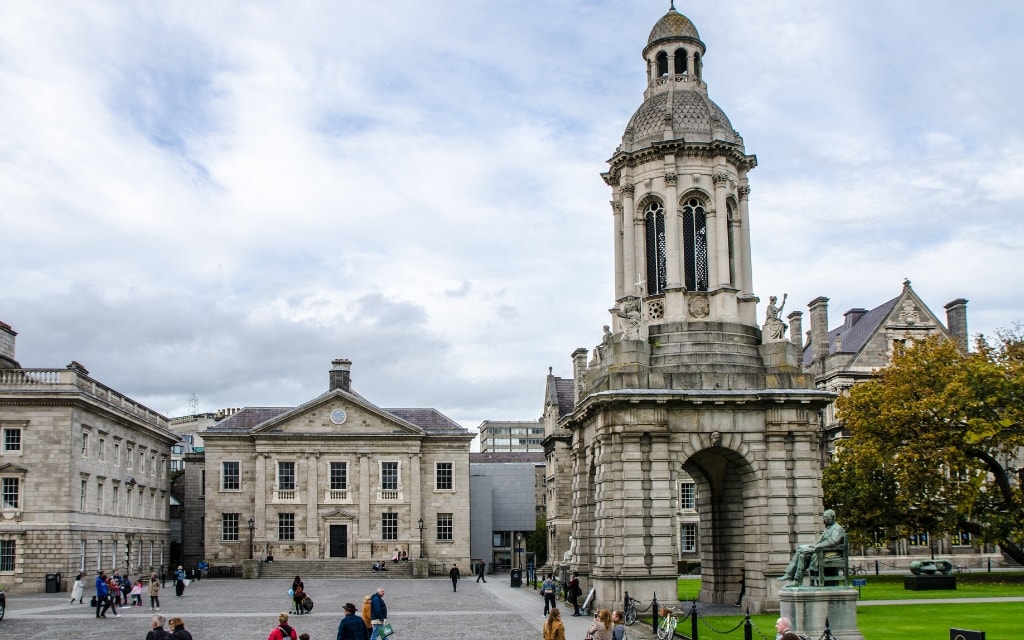
You can tour the Trinity College campus for free or take one of the tours with locals who will show you lots of interesting facts and tell you about the world-famous alumni (tours start at €15).
Old Library and Book of Kells
The biggest draw at Trinity College is the Old Library – Long Room and Book of Kells.
The Book of Kells contains the 4 Gospels of the New Testament and is an incredible 1200 years old. That’s a long time ago. To preserve the book as long as possible, the Book of Kells is hidden under glass. As part of the tour, you will also see a small exhibition relating specifically to the Book of Kells.
The library includes the Long Room, a long room with floor-to-ceiling oak shelves filled with more than 200,000 old books. Amazing view and one of the most beautiful libraries in the world (although the one in Prague is also beautiful).
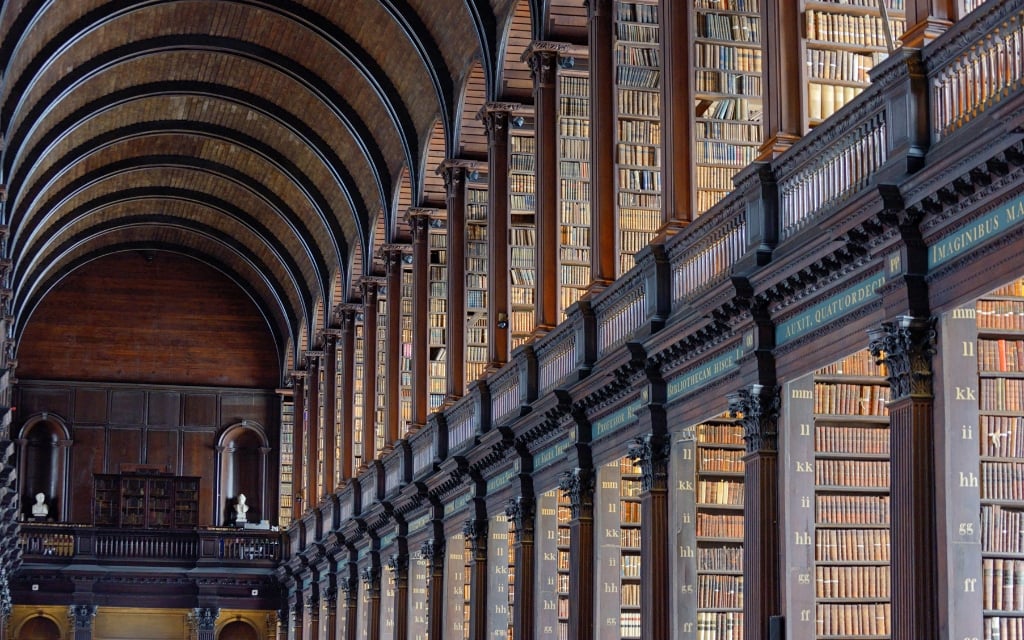
The library and the Book of Kells can be reached directly from the main courtyard – turn right here after the courtyard.
How to skip the line for the Book of Kells and Old Library: As this is one of the most popular places in Dublin, book your tickets in advance. The price for the tour is 21,50 €.
How to get there: Trinity College is located in the city centre, just south of the River Liffey. The easiest way to get here is on the green tram line (Trinity stop).
2. Molly Malone statue
Just a short walk from Trinity College you’ll find a bronze statue of fishmonger Molly Malone. And what makes it special? Molly Malone is the main heroine of the famous Irish ballad Molly Malone (or Cockles & Mussels), which has become the unofficial anthem of Ireland.
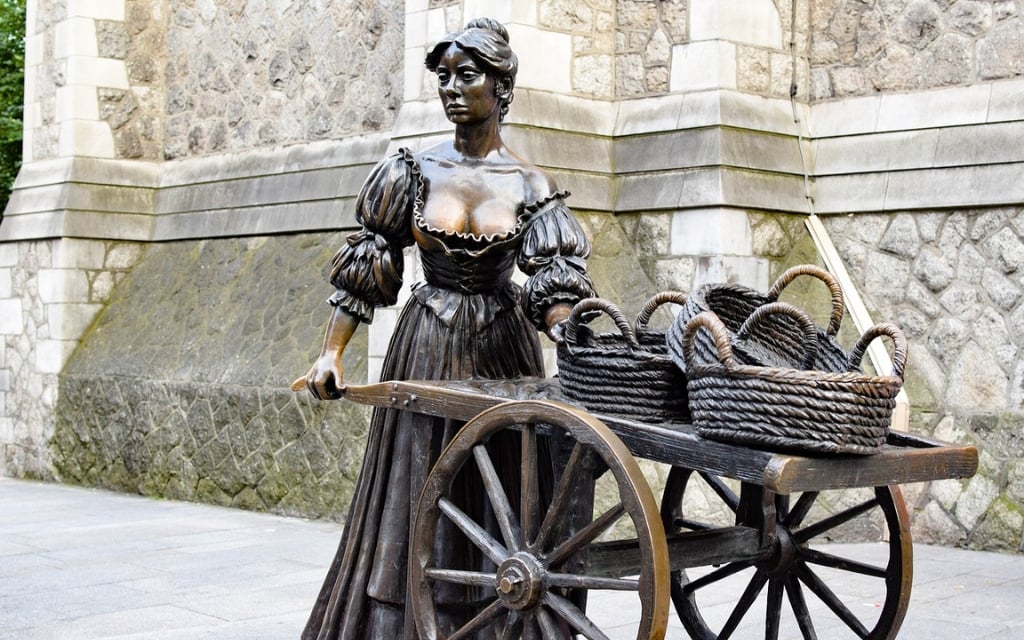
The statue stands in front of the church between Trinity College and Grafton Street.
3. Grafton Street – things to do in Dublin
Where to go shopping in Dublin? Definitely Grafton Street and the surrounding streets. Grafton Street is one of the busiest shopping streets in Europe.
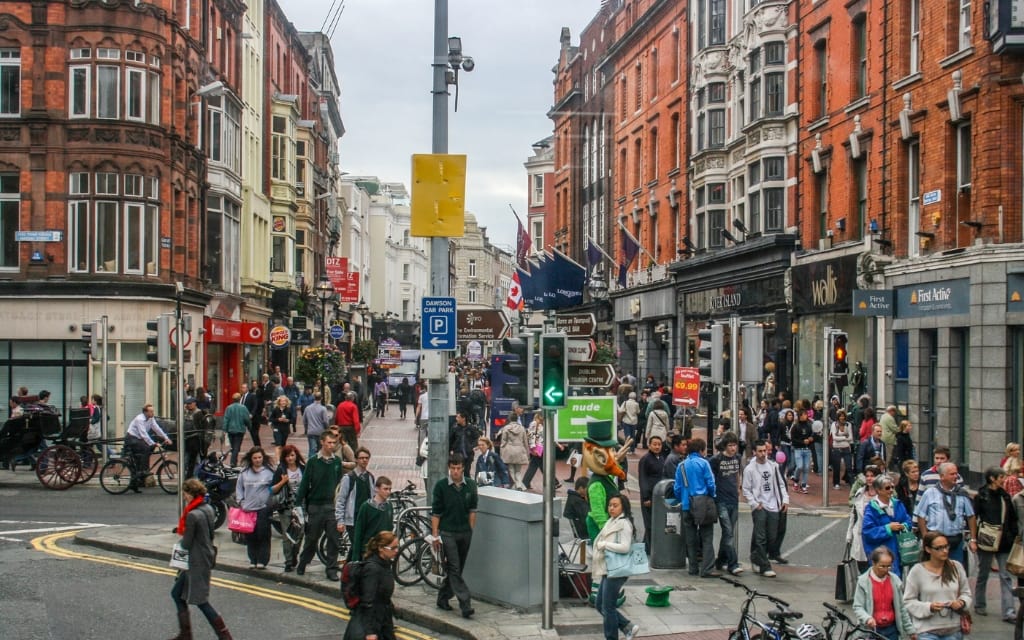
She’s also famous for another reason. This is thanks to the buskers – the singers who perform on Grafton Street. Just making the day of the passersby or trying to make a name for themselves here. Some of the well-known names who have succeeded include Bono and Glen Hansard.
Hotels in Dublin 😴
4. St Stephen’s Green
Once you pass Grafton Street, you come out at St Stemphen’s Green. An oasis of green in the centre of Dublin with a lake, nooks and crannies, flowers and seagulls. There are plenty of seagulls and sometimes they are quite cheeky, so keep an eye on your snack.
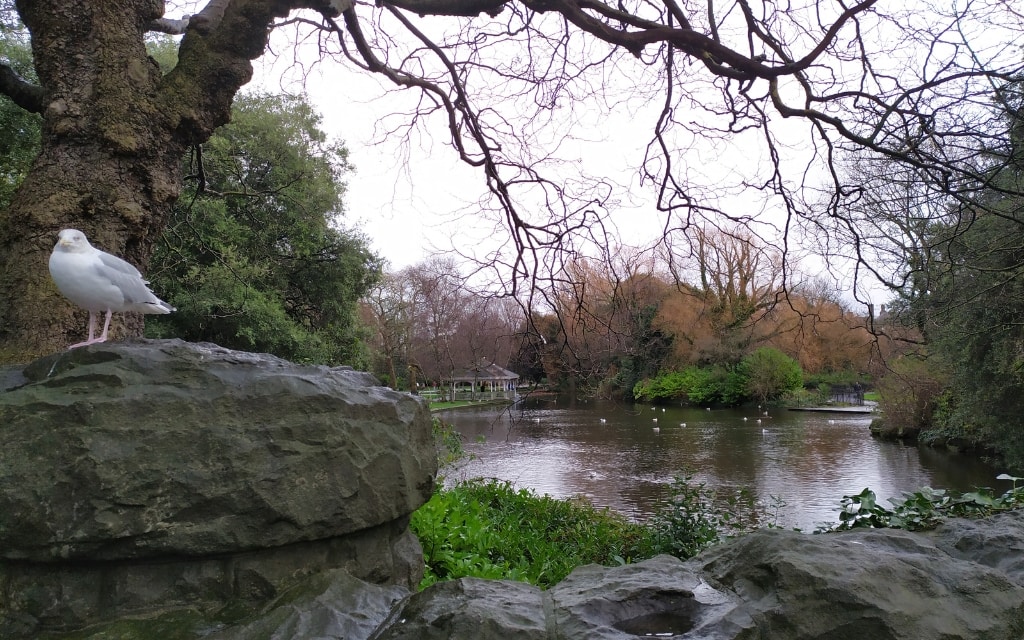
The entrance to St Stephen’s Green is through Fusiliers’ Arch. It was dedicated to the fallen soldiers during the Second Boer War at the turn of the 19th century.
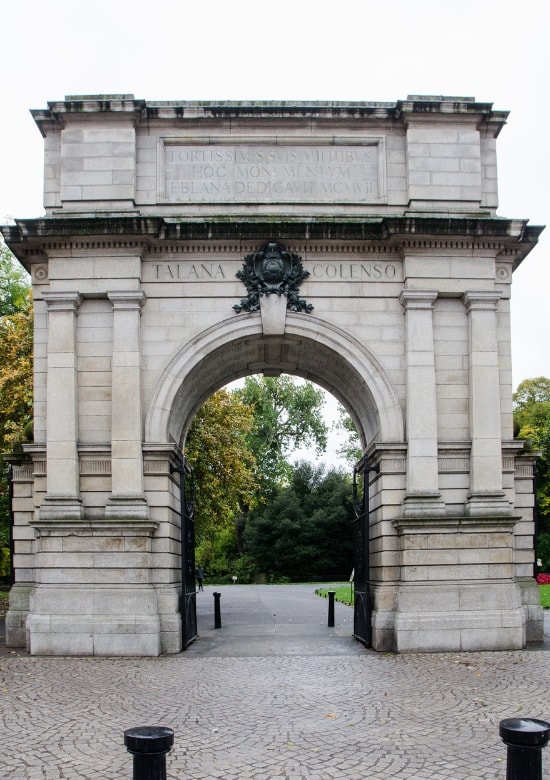
How to get there: green tram line – St. Stephen’s Green stop; buses 32X, 41X, 181, 193, 194, 194A, 824
Tip: If you like interesting architecture (or shopping), head to Stephen’s Green Shopping Centre (on the corner of Kings St and St Stephen’s Green).
5. National Museum of Ireland
The National Museum of Ireland covers several areas. Each of them is based in different premises:
- The National Museum of Ireland-Decorative Arts & History is located on the north bank of the River Liffey. Here you can learn more about the history of Ireland and see luxury fashion, silver and other decorative items.
- The National Museum of Ireland – Archaeology is the most popular. It lies between St Stephen’s Green and Trinity College. It includes archaeological finds from the Bronze Age, Viking Age and the Middle Ages and several Egyptian artefacts and mummies.
- The National Museum of Ireland – Natural History is adjacent to the archaeology branch. It focuses on Irish fauna – you will see the largest trout in the world (11.8 kg) or the giant deer that used to live in Ireland.
All museums have free admission and the same opening hours: Tuesday-Saturday 10:00-17:00, Sunday-Monday 13:00-17:00.
The National Gallery of Ireland is adjacent to the archaeology and natural history branch. A place that no art lover should miss. It houses a collection of European masters from the 14th to the 20th century (Picasso, Velázquez, Rembrandt, Monet, Goya, Degas and many others). Admission to the permanent exhibition is free.
6. Merrion Square
Merrion Square is in front of the National Gallery. A wonderful square with a park surrounded by original Georgian houses from the turn of the 18th century. With coloured doors, columns and typical red brick panelling.
It was during this period that the Georgian style prevailed in Ireland – the name comes from the four English Hanoverian kings, all named George.

If you look at the houses around Merrion Square in more detail, you will notice that they have slightly different heights. Each house had a different tenant and thus a different builder. Tenants at that time were given leases of 50-100 years. When the time limit expired, it was assumed that the original houses would be demolished and rebuilt by new tenants.
The park is famous for its colourful statue of Oscar Wilde, who is perched on a rock from the Wicklow Mountains (a mountain range south of Dublin), looking up at the house where he lived as a child.
7. Temple Bar
The most famous pub in Dublin (and perhaps the world) is the Temple Bar Pub. She is so famous that an entire neighborhood was named after her. The district extends along the south bank of the River Liffey.
Cobbled streets that line the houses with colourful panelling and lots of flowers. That’s what Temple Bar is. An area with a huge concentration of pubs and taverns.
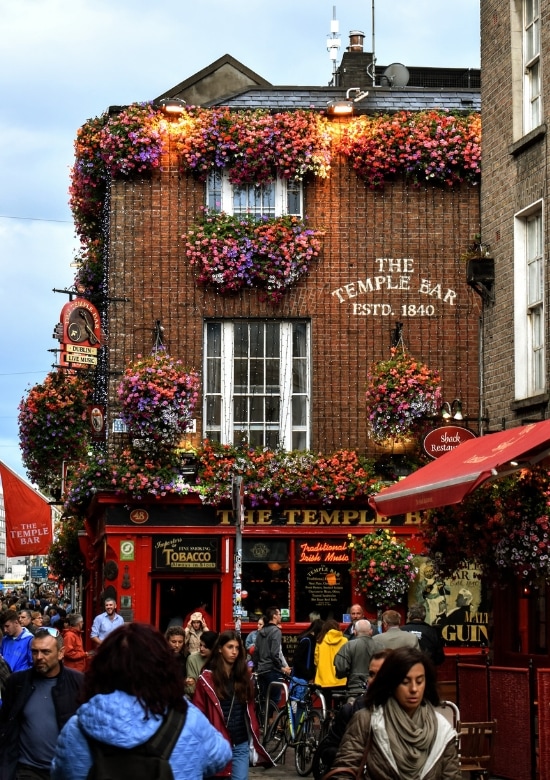
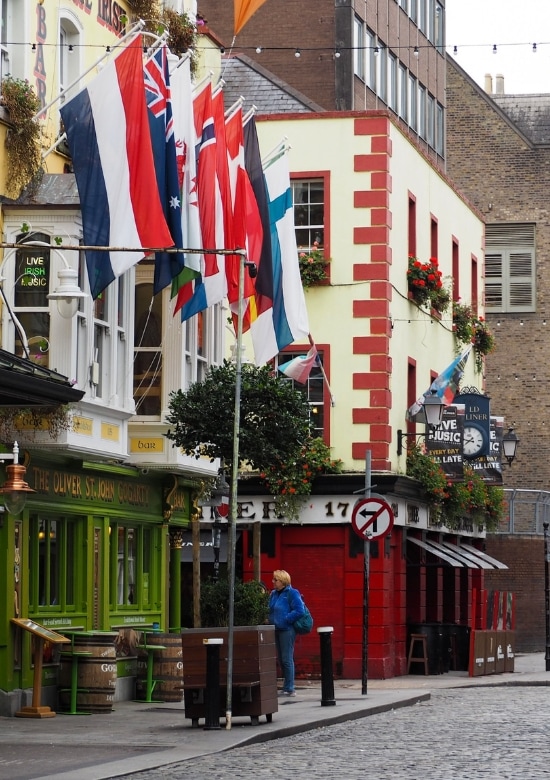
The most famous one is the aforementioned Temple Bar Pub, which you can recognize from afar thanks to its red paneling and crowds of tourists.
The pub has been open since 1840 and is still one of the best pubs in Dublin. With a traditional atmosphere, live music and great food and beer (and whiskey – it has the largest selection of Irish whiskey). As a result, it has held the title of “Traditional Irish Music Pub of the Year” since 2002.
It has also won other awards – for the world’s largest selection of pub sandwiches, for example, or the Guinness World Record for the longest guitar marathon (David Browne played guitar for an incredible 114 hours).
Temple Bar is the most touristy and expensive area in Dublin. Still, it’s worth every euro.
8. Guinness Storehouse – things to do in Dublin
When you say Dublin, most of us probably think of Guinness. A black, thick beer with a bitter taste that is known all over the world.
A tour of the Guinness Storehouse is one of the most popular attractions to visit in Dublin. It’s fun, interactive (even if you’re not a beer fan like me) and full of interesting facts about beer production and history (7 floors in total!). Finally, enjoy a tasting on the rooftop terrace overlooking Dublin.
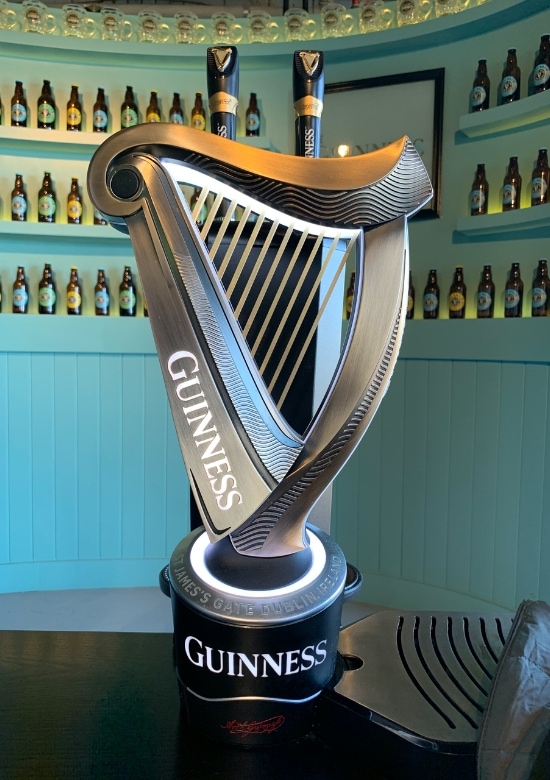
Admission: Tickets to the Guinness Storehouse start at €26 for adults. This is one of the most popular things to do in Dublin – booking in advance is essential to skip the line. Get your tickets here.
Opening hours: Sunday-Friday 10:00-19:00 (last entry at 17:00), Saturday 9:30-18:30 (last entry at 17:00)
How to get there: The Guinness Storehouse is outside the centre but still within walking distance (about 20 minutes from Dublin Castle or St Patrick’s Cathedral). The easiest way to get here is by bus (lines 13, 123, 61 or 62) – get off at James Street.
9. St Patrick’s Cathedral
St Patrick’s Cathedral is another Dublin landmark not to be missed. After all, what other cathedral boasts the title of the national cathedral of the Church of Ireland.
The cathedral was built by the locals in 1220 on the site of an old well which, according to legend, was used in the 5th century by St. Patrick himself to baptize people into Christianity.
Jonathan Swift, author of Gulliver’s Travels, is buried inside.
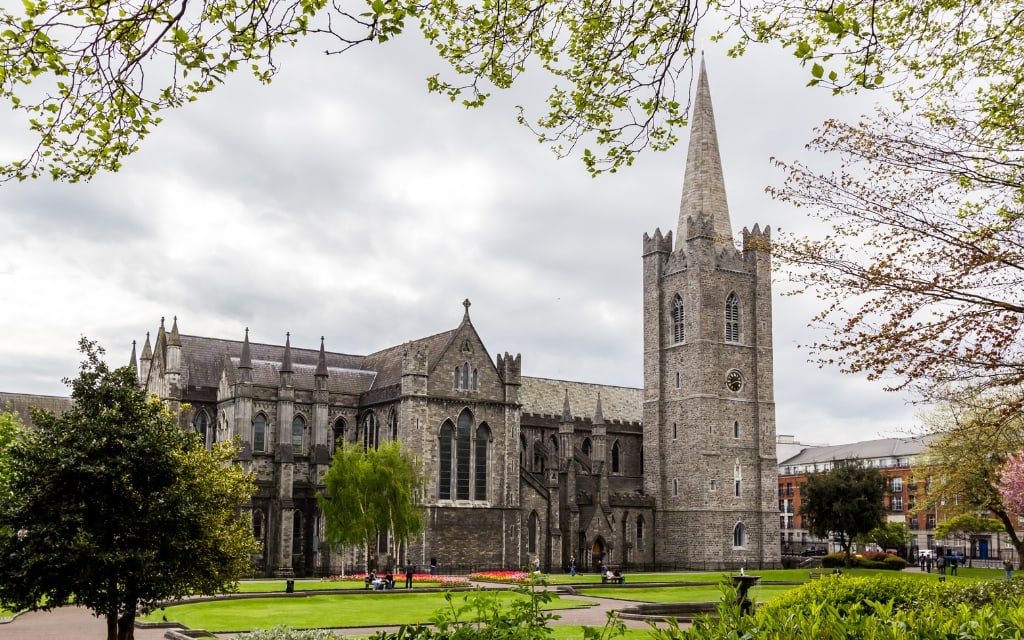
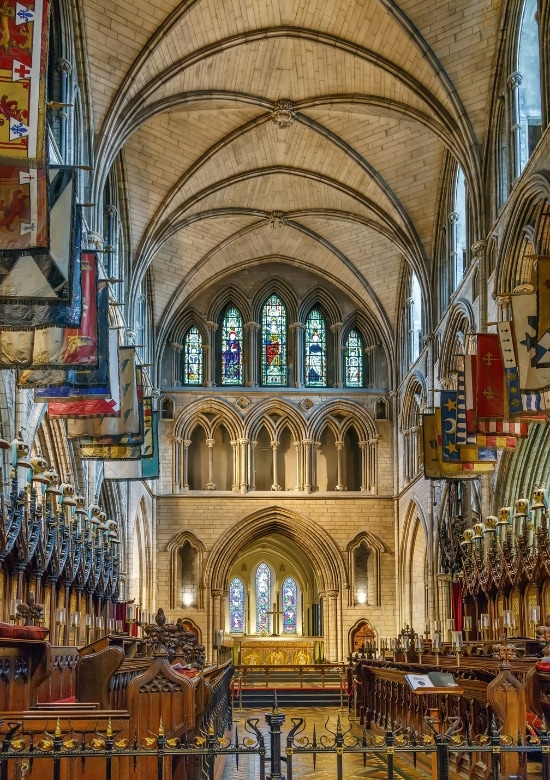
Next to the cathedral is a small, well-kept park with flower beds, benches and a small playground. On the other side of the cathedral is the entrance to the oldest library in Dublin – Marsh’s Library.
Admission to St Patrick’s Cathedral: Full admission is €10, reduced admission for seniors over 60 and students is €9, and €4.50 for children 6-12. Get your tickets here.
Opening hours: the Cathedral is open Monday to Friday 9:30-17:00 (last entry), Saturday 9:00-17:00 (last entry) and Sunday 9:00-10:30 and 13:00-14:30.
How to get there: St. Patrick’s Cathedral is easily accessible on foot and located in the city centre. Besides, buses 27, 49, 54A, 56A, 77A, 150, 151 stop here.
Read: The best things to do in Scotland
10. Christ Church Cathedral
If you continue north along the main street from St Patrick’s Cathedral, you will reach another important cathedral in a few minutes – Christ Church Cathedral. The oldest building in Dublin (dating back to 1030), which was originally a Viking church.
Inside Christ Church Cathedral is the famous mummified cat and rat or the largest crypt in Ireland and the UK.
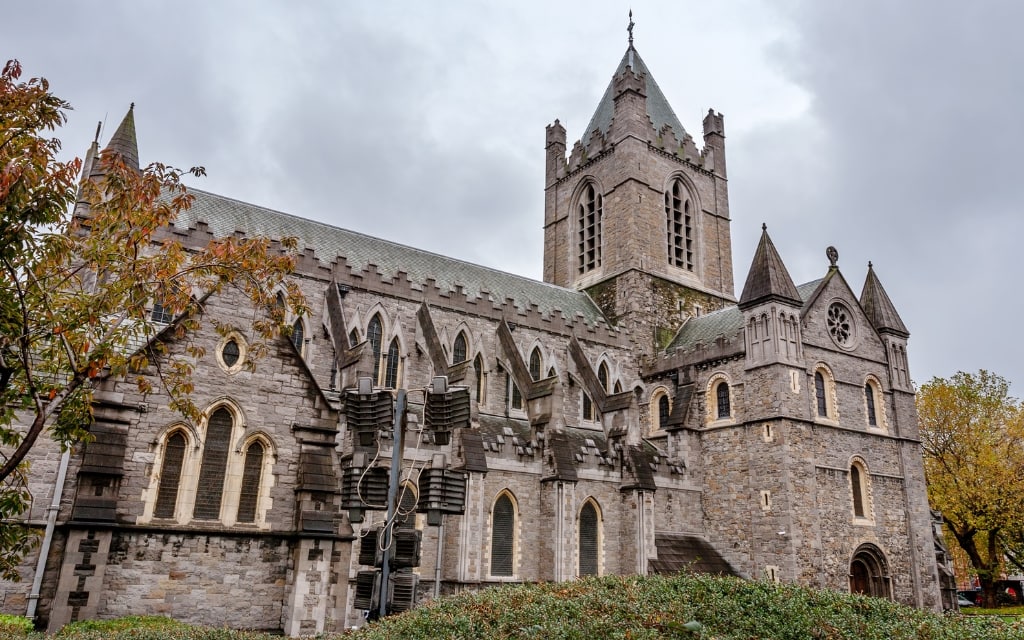
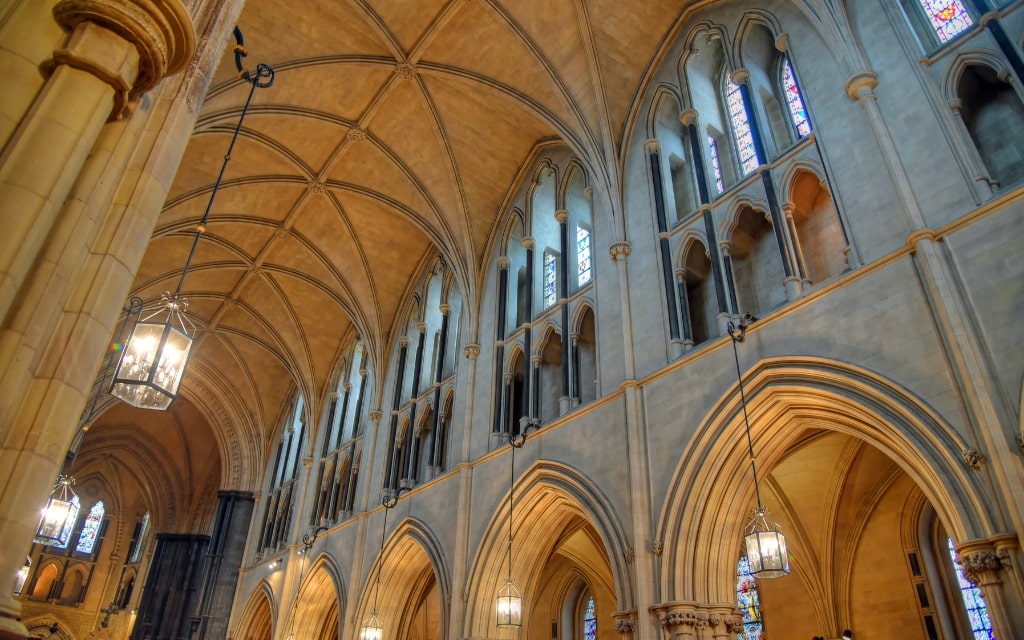
Admission to Christ Church Cathedral: Full admission is €11.50, reduced admission for seniors and students is €10 and €4 for children under 12. Audio guide included (English, German, Spanish, Italian, French).
Opening hours: Monday-Saturday 9:30-17:00 and Sunday 12.30-15:00 (last entry always 45 minutes before the end of opening hours)
How to get there: Christ Church Cathedral is a 5-minute walk from Dublin Castle or St Patrick’s Cathedral. Buses 123, 12, 27, 40 stop here. 49. 77A, 77X.
Tip: Adjacent to Christ Church Cathedral is the Dublinia Museum, which focuses on the history of the Vikings in Ireland. Interactive museum suitable for families with children. As part of your visit, you can climb the medieval tower and enjoy views of Dublin city centre.
Read: Best things to do in Ireland
11. Dublin Castle
Dublin Castle is one of the most famous sights to see in Dublin. The castle was built in the 13th century on the site of a former Viking settlement. For centuries it served as the seat of English and then British administration.
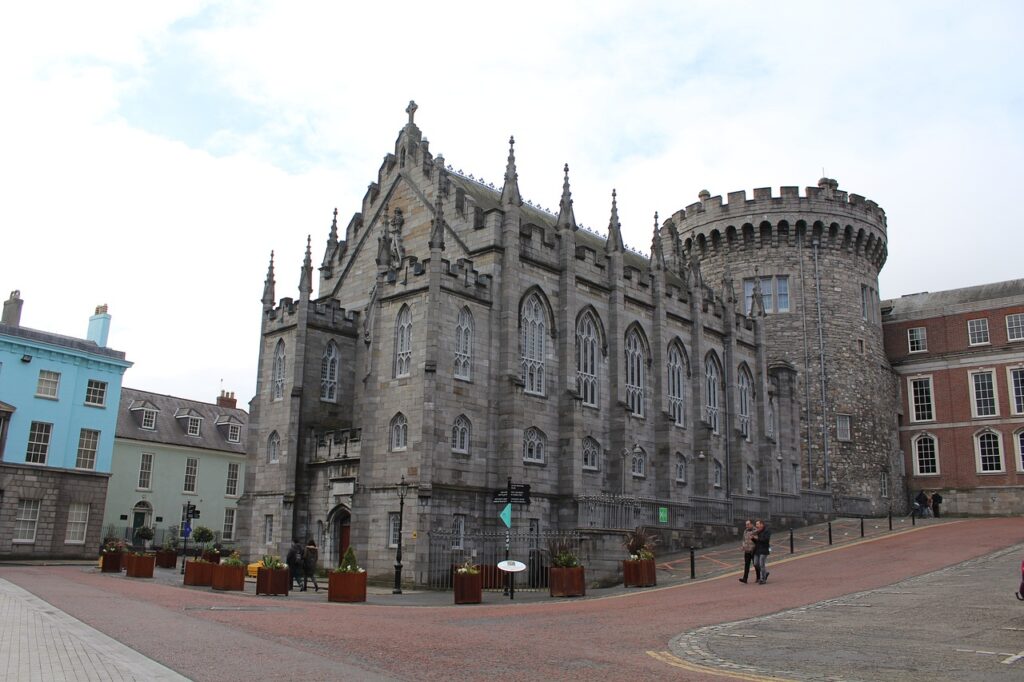
After Ireland’s independence in 1922, it became a major government complex. This is why its interior will remind you more of a government institution or a castle. It is not a typical castle such as Edinburgh Castle.
Admission: full admission is 8 €, reduced admission for seniors and students 6 €, for youth 12-17 years 4 € and children under 12 years are free. Tickets do not need to be booked in advance.
Opening hours: daily 9:45-17:45 (last entry at 17:15)
How to get there: Dublin Castle is centrally located, just minutes from Christ Church Cathedral or Trinity College.
Hotels in Dublin 😴
12. Teeling Whiskey Distillery
Irish whiskey is a concept. And there are several distilleries in Dublin that you can visit as part of your tour. The most famous one is Jameson Distillery (more about it in a moment). But the Teeling Whiskey Distillery is also worth a visit, a short walk from St Patrick’s Cathedral (10 minutes).
Teeling Whiskey Distillery only opened in 2015. 125 years before that, no new distillery had been built in Dublin. Unlike the Jameson Distillery, the tour is unique because you get to see the distillery in action. It is not just a museum, but a fully functioning distillery.
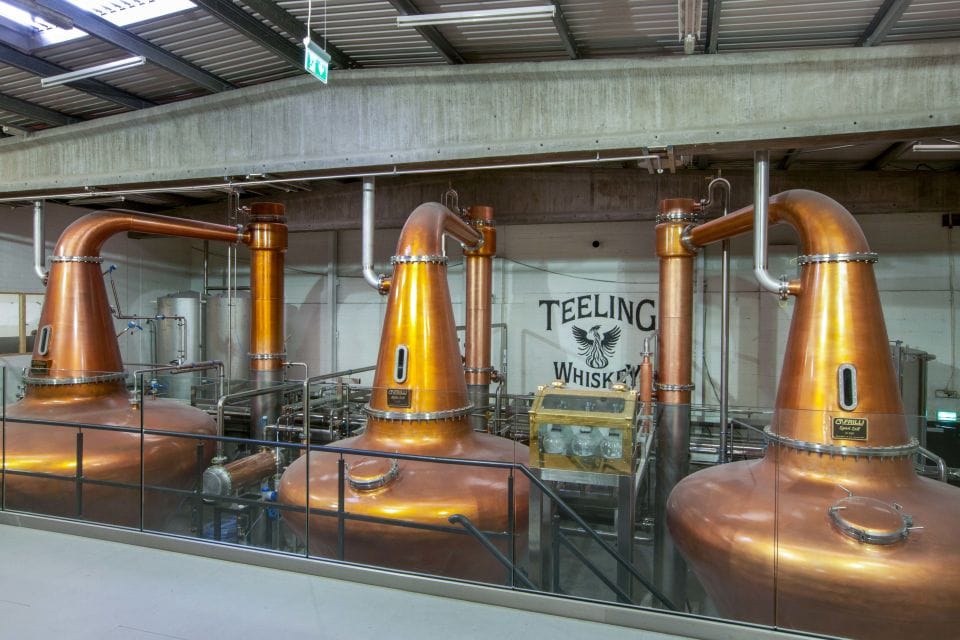
Sustainability is another reason why Teeling Whiskey Distillery is worth a visit. Its systems capture rainwater, use a local well and use the excess energy produced during the manufacturing process to heat the visitor centre. This has earned it awards for Sustainable Distillery or “Best Visit in Ireland”.
- Admission: prices for tours start at 20 €. Get your tickets here.
- Opening hours: Monday to Wednesday 12:00-18:00, Thursday to Friday and Sunday 11:00-18:00, Saturday 11:00-19:00
- Getting there: bus 150, 27, 56A, 77A, 151; 10 minutes walk from St Patrick’s Cathedral
13. Ha’penny Bridge
There are a number of bridges in Dublin. The most significant is the Ha’penny Bridge, which connects the Temple Bar and North City districts on the north bank of the River Liffey.
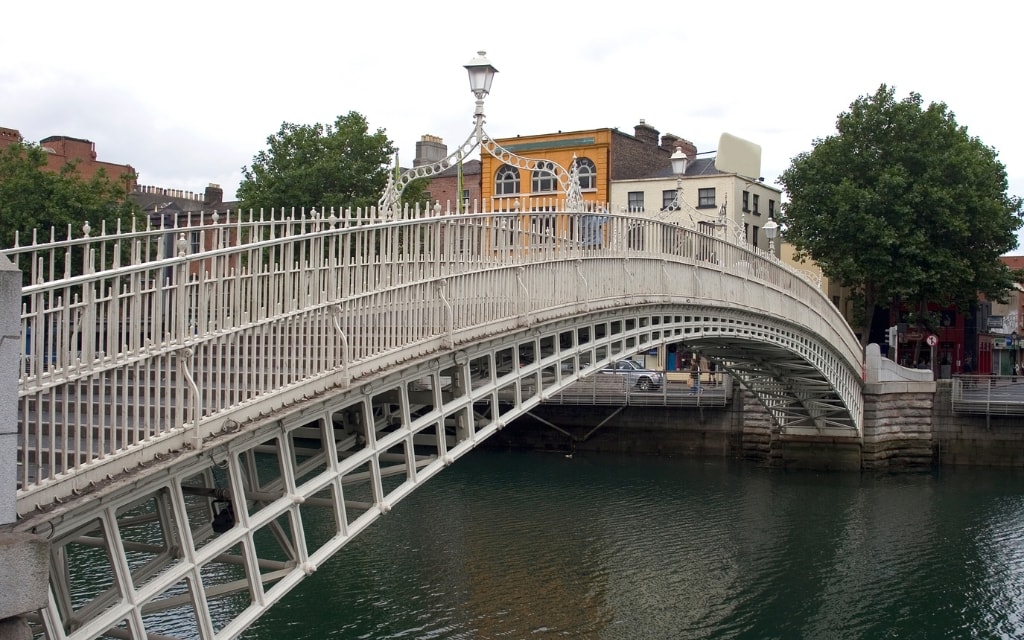
The white cast iron Ha’penny Bridge dates back to the 19th century. It is 43 metres long and 3 km wide. For 200 years it was the only pedestrian bridge in Dublin.
Before it was built, a local ferry used to cross the river. This was then replaced by the Ha’penny Bridge – you paid half a penny for passage (as well as for the ferry). And how was the ferryman? He received £3,000 compensation from the city and a 100-year lease on the bridge.
Tip: A boat trip is another way to experience Dublin from a different angle. You will see Temple Bar, the waterfront, Docklands and drive under several bridges, including. Ha’penny Bridge.
14. The Spire and O’Connell Street
We crossed the Ha’penny Bridge to the north bank of the River Liffey. A short walk from the bridge is busy O’Connell Avenue, in the middle of which stands a 120-metre high, steel, spire-shaped structure – The Spire.
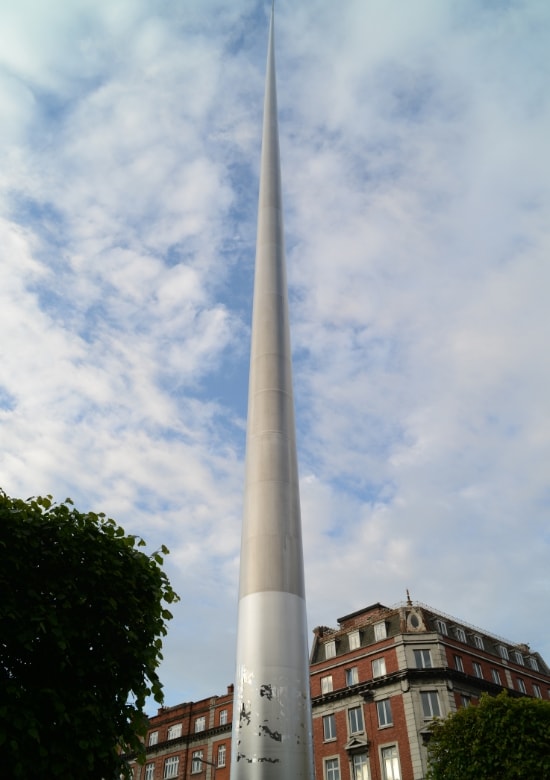
The Spire replaced the destroyed Nelson’s Pillar from the 1966 bombing. It consists of 8 hollow cones that gradually narrow from a width of 3 metres to 15 cm. It serves as a popular meeting place for locals or, thanks to its height, as an easy point of orientation in the city. Plus, it shines like a beacon at night.
Next door, the historic GPO Museum tells the story of the 1916 Easter Rising and modern Irish history in an engaging way.
15. Jameson Distillery Bow St.
Jameson Distillery is one of the world’s leading whiskey distilleries. John Jameson founded the distillery in 1780.
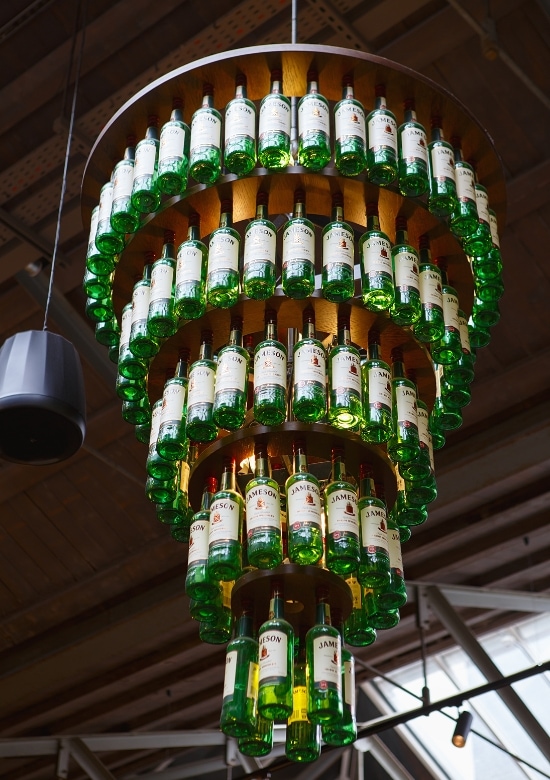
Jameson Distillery is now based elsewhere and here in the original grounds they have built a visitor centre with lots of fun tours. You’ll learn how to drink whiskey like a pro, how the types of glasses affect the taste of whiskey, how to mix your own whiskey and a tasting.
Admission and opening hours: Jameson Distillery Bow St. is open Monday-Thursday 10:00-18:00, Friday and Saturday 11:00-19:00 and Sunday 12:00-18:00. Prices for the tour start at €26. Get your tickets by clicking here.
How to get there: red tram line – Smithfield stop.
Tip: Are you hesitating which distillery to visit? If you can’t decide, visit the Irish Whiskey Museum which is not focused on any one brand. He will guide you through the history of production and there is also a tasting. Located in the centre opposite Trinity College.
16. EPIC – The Irish Emigration Museum
EPIC Museum is an unusual museum that gives you a glimpse of Ireland from the perspective of Irish emigrants. More than 300 stories of writers, scientists, artists and politicians who have contributed to the Ireland of today. A great interactive experience to see Ireland from a different angle.
Admission: full admission is 21 €, reduced admission for seniors over 65 years 19 €, students 18,50 €, youth 13-17 years 14,50 € and children 6-12 years 10,50 €. Prices are discounted for online booking – get your tickets here .
Opening hours: the museum is open daily from 10:00-18:45 (last entry at 17:00).
How to get there: The EPIC Museum is located on the waterfront in Dublin Docklands. Buses 191 or 912 stop right in front of the museum. The red Luas line (George’s Dock stop) passes a short distance away.
17. Phoenix Park
Phoenix Park is nicknamed “Dublin Playground” by the locals. Dublin’s largest park, originally used as a royal hunting park. A huge herd of fallow deer (more than 450) remains from that time and you can see them freely grazing the local meadows.
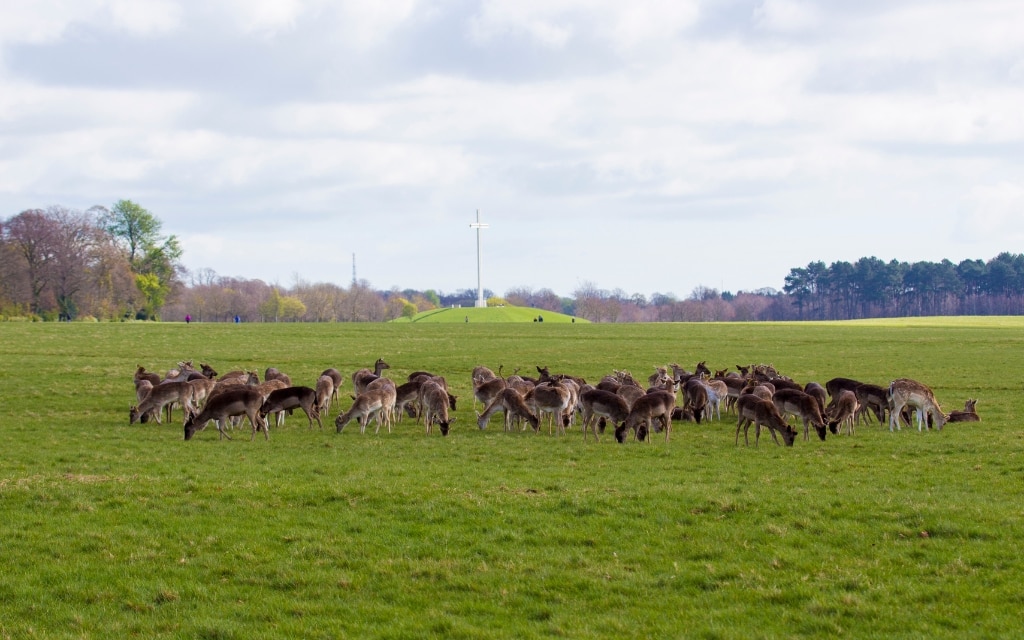
In addition to this, there is a zoo, Victorian flower gardens, a café, a tea room and other places to keep you entertained for the day.
Phoenix Park is a suburb of Dublin. It’s open 24 hours a day, free of charge, and there are various events throughout the year.
18. National Botanic Gardens
Beautiful botanical gardens with a Victorian palm greenhouse where squirrels scurry through the trees. Here you will see more than 15 thousand species of plants. The National Botanic Gardens are a great tip for long walks through the rose garden or greenhouses with exotic plants.
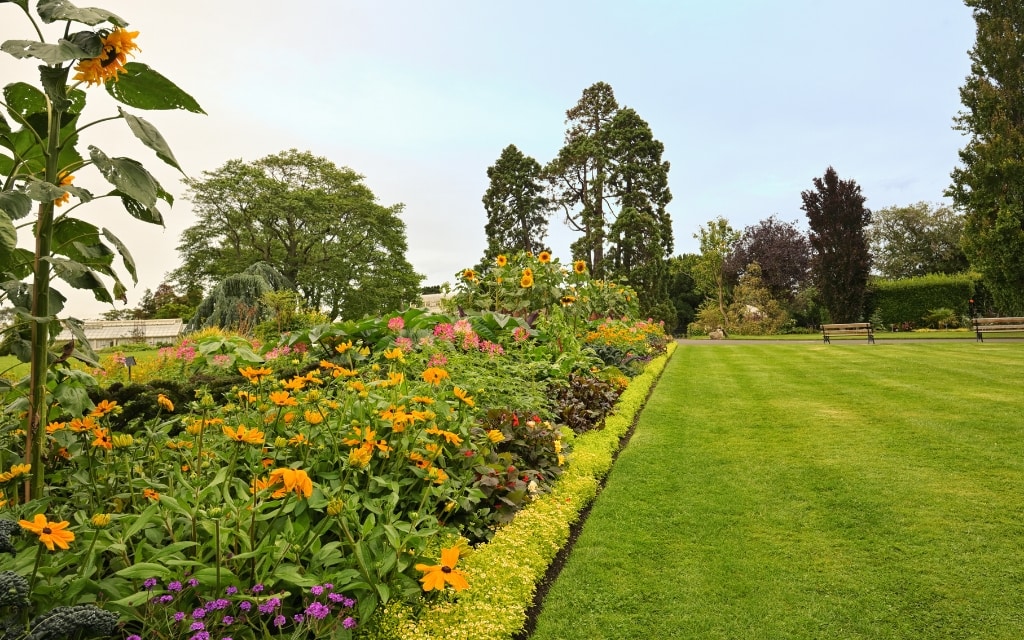
The National Botanical Gardens are another place outside the city centre. It’s in north Dublin and can be reached by bus 83 or 83A. The gardens are free of charge.
19. Dublin alleys
Dublin has plenty of charming cobbled streets lined with houses with colourful panelling, flowers and friendly locals. Just wander around and soak up the relaxed atmosphere. The locals are in no hurry and are not in a hurry. A nice refreshment compared to other hectic cities (yes, I’m thinking of London and New York).
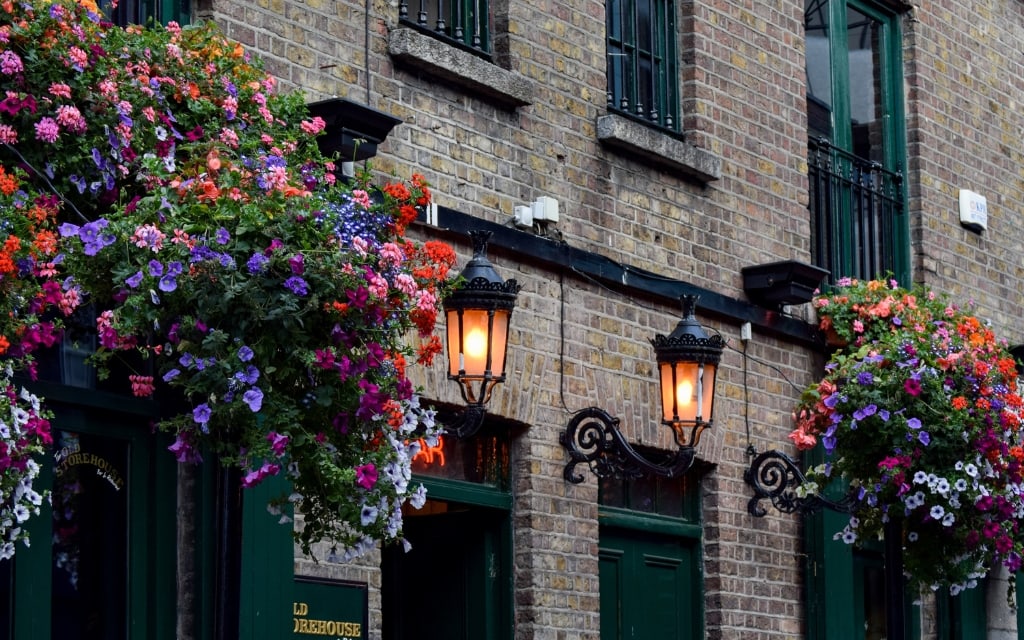
20. Cliffs of Moher
You can’t miss the Cliffs of Moher here, even if it’s not in Dublin. 200 m high and 14 km long cliffs, which are among the largest in the world. Thanks to this, they are on the UNESCO list. This is one of the most beautiful places to visit in Ireland and definitely worth a day trip from Dublin.
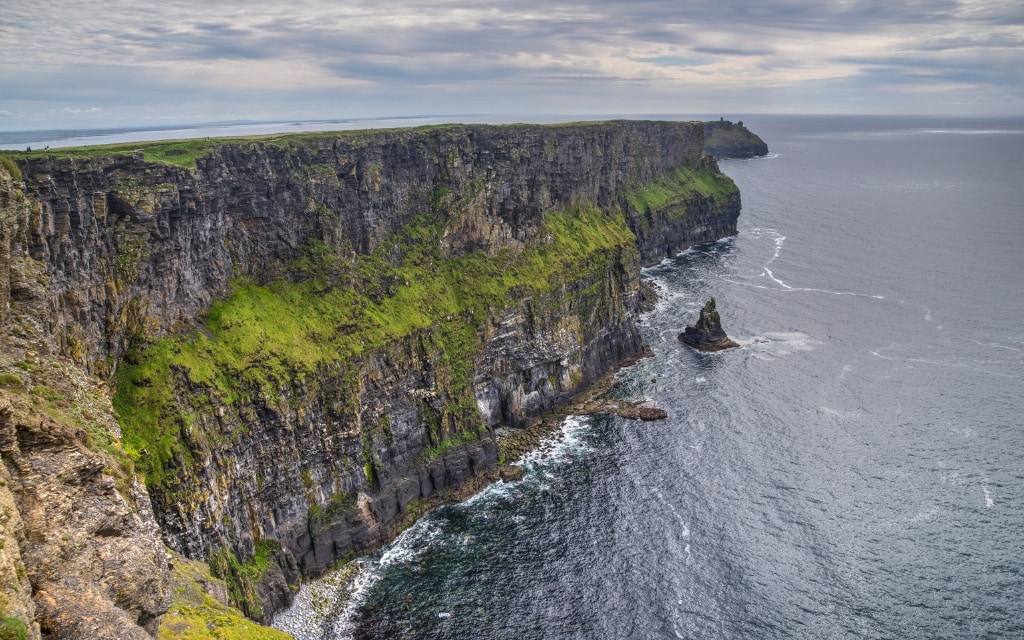
The Cliffs of Moher are located on the west coast of Ireland. There are several ways to visit them:
- Public transport: The cliffs can be reached by buses (usually with 1 transfer; there are no direct buses or trains). The downside is that you will spend 4.5-5 hours each way.
- Rent a car and take a trip to the cliffs on your own. The journey takes about 3 hours and is mostly on the motorway. To rent a car, simply fill in your details and show your ID upon pick-up. The price also includes insurance and free cancellation. You can pick up your car at the airport or at several other locations in Dublin (the pick-up location is always written on the car).
- Take the direct bus to the Cliffs of Moher. Buses leave from Hugh Lane Gallery in the city centre (there is a bus stop) and make a circular route through some of the most beautiful places on the west coast. You’ll explore the Cliffs of Moher, the lunar landscape of The Burren National Park and the beautiful town of Galway. Plus, it’s a great price that includes entry to the parks. You don’t have to worry about anything, the bus will take you to your destination.
Top 10 places to visit in Dublin
Do you have limited time and want to visit the best Dublin has to offer? Below you will find our top 10 places not to miss in Dublin:
- Trinity College
- Temple Bar
- Guinness Storehouse
- St Patrick’s Cathedral
- Christ Church Cathedral
- Dublin Castle
- Ha’penny Bridge
- Jameson Distillery Bow St. / Teeling Whiskey Distillery
- St Stephen’s Green
- Grafton Street
Where to stay in Dublin
- Castle Hotel – Cosy 4* hotel in a quiet street with excellent access to the centre and airport
- Beresford Hotel – A popular central hotel in the mid-price range
- Abbey Court Hostel – Budget accommodation with full facilities (terrace, laundry, shared kitchen, PC, games room) in the centre with airport stop right outside the hostel
- Staycity Aparthotels – Modern apartments with kitchenettes ideal for couples and families
Best Things to do in Dublin – Map
HOW TO USE THIS MAP: Above you will find a detailed map with tips on the things to do in Dublin. Click at the top left of the map to see separate layers with highlighted locations. You can hide and show the different layers or click on the icons on the map to see the names of the places I mention in the Dublin guide. If you want to save the map, star it. For a larger version, click on the icon in the upper right corner.
Dublin prices
Dublin is an expensive city on average, although it is slightly cheaper than London and Paris (from a tourist perspective).
You’ll pay around €20 for a meal in a cheap restaurant and around €90 for a 3-course dinner for two. Fast food is on average €10-12 and a pint of Guinness will set you back €6-7 (a bit more at Temple Bar). Some places occasionally hold events where you can get drinks much cheaper.
The prices of basic foodstuffs are as follows:
- Milk 1 l – 1,33 €
- White bread 500 g – 1,95 €
- Eggs 12 pcs – 3,98 €
- Cheese 1 kg – 7,79 €
- Chicken breast 1 kg – 9,93 €
- Bananas 1 kg – 2,02 €
- Water 1,5 l – 1,61 €
- Potatoes 1 kg – 1,86 €
Where to eat in Dublin
Dublin is famous for its pubs, of which there are more than 700. Almost every street has its own pub. And what a pub, what an original. Some places just have beer on tap, others have live music or dancing.
In addition to the aforementioned Temple Bar Pub in the Temple Bar district, The Brazen Head is also worth a visit. Dublin’s oldest pub, which has been around since the 12th century. Once a den of rebels, now a lively pub with music and atmosphere.
Or go to M.J. O’Neill. It is located in the centre, directly opposite the Molly Malone statue. It was packed, but still retained an authentic atmosphere with live music and great food.
When you walk past pubs in Dublin, you’ll hear traditional Irish music, called Trad for short, coming from some of them.
When visiting Dublin, you must try their fried cod and chips with vinegar and salt. And where to go for delicious Fish & Chips? Definitely Leo Buldock. Many celebrities have enjoyed Fish & Chips here, including Bruce Springsteen, Mick Jagger and John Malkovich. They even have a complete list of names posted next to the window. The first branch is located in a small alley in Temple Bar and the second a short walk behind Christ Church Cathedral.
Or would you rather have something healthier? Chopped makes delicious salads, burritos, soups, acai or smoothies. There are several branches in Dublin, for example at Trinity College and St Stephan’s Green.
What to eat in Dublin and Ireland
When you visit, you must try the stew or anything with potatoes, because potatoes are the number one ingredient here.
A typical dish is Coddle, for which there is not even a recipe, because it is used to consume leftovers. It is usually made by stacking sausage, potatoes, onions, herbs and often barley, which is generally popular in Ireland.
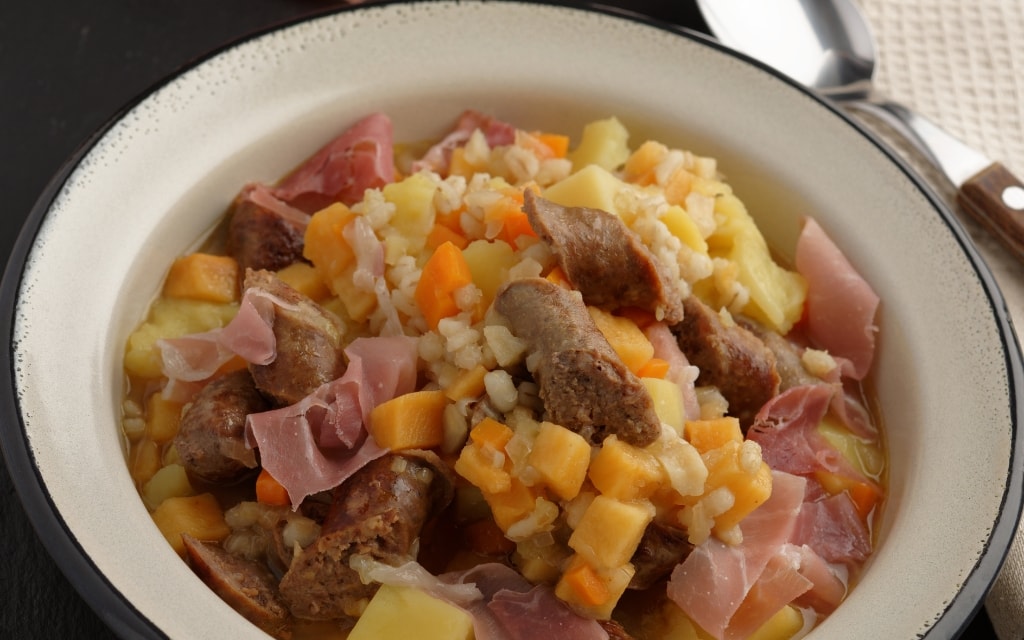
A classic is the Irish Stew made from lamb, potatoes, onions, carrots and bacon. Or try Boxty, the little potato pancakes. As Dublin is by the sea, the locals eat a lot of seafood too.
To accompany the goulash, you can nibble on Soda Bread, a quick bread where soda is added instead of yeast to make it rise. Locals have it with smoked salmon or sweetly with jam.
In the morning, you’ll regain your strength with a hearty Irish breakfast that has a little bit of everything – bacon, sausages, mushrooms, tomatoes, ox eye, beans, boxty and sometimes bread.
Drops of alcohol are added to desserts. The same goes for Irish coffee, which is made with coffee, a shot of whiskey, sugar and lightly whipped double cream.
Read: The Complete Guide to Transport in Dublin
Dublin Pass: How to save in Dublin
You can easily save money in Dublin with the Dublin Pass. It depends on what you want to visit. Based on this, you can calculate whether the card is worthwhile.
There are 2 Dublin Pass options to choose from:
- All-Inclusive Pass, where you purchase the number of days your card will be valid for – 1, 2, 3, 4 or 5 days.
- Explorer Pass, where you buy a number of attractions (3, 4, 5 or 7 attractions) that you have 60 days from the activation of the card to visit.
And how does the card work? On the official website you choose the type of Dublin Pass which will then arrive in your email. From there, you download it via a mobile app (or print it as a pdf if you prefer) and just scan the card code on entry.
The card is only activated when you enter the first attraction, not when you buy it. Some places require advance booking.
☞ Is travel insurance to Ireland necessary? Your European Health Insurance Card (EHIC) will cover necessary medical treatment due to illness or accident. However, the insurance does not cover any deductibles (for example, for hospitalisation, dental treatment or medicines). It is the travel insurance that covers these deductibles, as well as situations such as trip cancellation, loss of luggage or liability insurance. Find out more about, what travel insurance covers.
Useful tips for enjoying Dublin
- Currency: euro
- Official language: english, irish
- Sockets: plug type G with three pins; 230 V/50 Hz
- Before you cross, take a good look to your right. In some places, notices on pavements or roads remind you of this.
- Near the main sights in Dublin, you’ll find blue signs that make it easy to find your way around. Everything is also well marked.
- You can get wifi almost everywhere in the city – on buses, at the airport, in cafes, etc.
- Tipping is not compulsory, but 10-15% is given if you choose to tip.
- And when you head out into the countryside, you’ll probably be pleased to know there are no snakes in Ireland.
Weather in Dublin
The weather in Dublin is oceanic and humid. For most of the year there are pleasant temperatures without major temperature fluctuations. In summer, the temperature rarely exceeds 25 °C (77 ℉), but there are still a few hot days when you can go to one of the beaches.
Winters are mild in temperature, but the cold air can make them feel colder.
Dublin is often cloudy and rainy. It’s rare to see a perfectly blue sky without a cloud. The sea is relatively cold. Even in summer it reaches an average of 15 C (59 ℉)
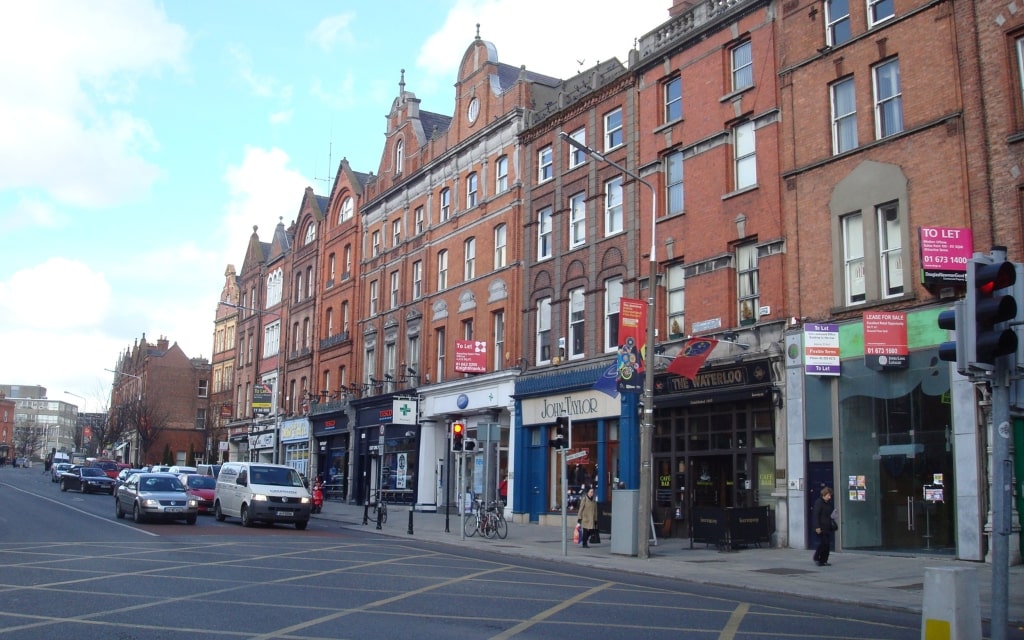
When to visit Dublin
Given the weather in Dublin, the best time to visit is June-September. In addition, later in the spring, Dublin blooms beautifully with cherry blossoms and tulips. The downside is that accommodation and airfares are at their highest at this time. At the same time, it’s the place with the most tourists. Although Dublin is generally not as crowded as other cities(Rome, Barcelona), some places can still be crowded.
The streets of Dublin also fill up around St Patrick’s Day (17 March), when the 5-day festival takes place.
How long to visit Dublin for
Dublin city centre is not big and can be walked around in one day. However, in such a short time you would not be able to see almost any of the sights or soak up the atmosphere of the city and that would be a great pity.
Therefore, I recommend to set aside at least 2-3 days to visit Dublin or 3-5 days if you are planning a trip around Dublin.
Safety
Dublin is a very safe city. Even at night. Watch out for pickpockets around Temple Bar and near the main station.
In general, just use common sense. If you don’t feel good about something, go with your intuition.
Plan your trip quickly and easily. If you buy something through our links, we get a small commission. You pay nothing extra. Thank you!
If you have a question about tips on things to do in Dublin, we’ll be happy to answer any questions in the comments. Have a safe journey!
More information about Ireland
DUBLIN: Get inspired by our tips for day trips around Dublin. Here is a complete guide to transport in Dublin.
THE BEST PLACES IN IRELAND: Check out 25 tips on things to do in Ireland.
RENT A CAR: Here’s a detailed guide on how to rent and drive a car in Ireland (prices, requirements, procedure, driving tips and what to avoid).
Summary: Things do in Dublin
Some of the best sights and attractions to visit in Dublin include the Trinity College campus, St Patrick’s Cathedral, the Guinness Storehouse and the Temple Bar district with its colourful tiling and lively pubs. Don’t miss a visit to a whiskey distillery – there are several to choose from.
But Dublin offers much more – you’ll find lots of tips, including useful information, in the article.
There are so many great activities to do in Dublin. Explore the historic centre south of the River Liffey with some of Dublin’s most famous sights. Wander the alleyways that are often perfectly hidden and yet so magical. Try whiskey in the distillery or visit the Irish pub and enjoy the authentic atmosphere with live music.
Taste the Guinness beer on tap in every pub. Or visit the Guinness Storehouse, where you can learn all about the making of Guinness beer and enjoy views of Dublin from the roof terrace. How about going to the lighthouse on the coast or taking a walk on the beach?
Dublin’s historic centre is easily walkable. For more distant places you can use buses, Luas trams or DART trains. Transport is fast, dense and reliable. Detailed information including links and a map can be found in the article.
There are over 700 pubs in Dublin serving delicious Irish food and Guinness beer. How else? Stews, potato dishes, Irish goulash and cabbage and bacon dishes are classics. The cuisine in Dublin is rich and honest.
